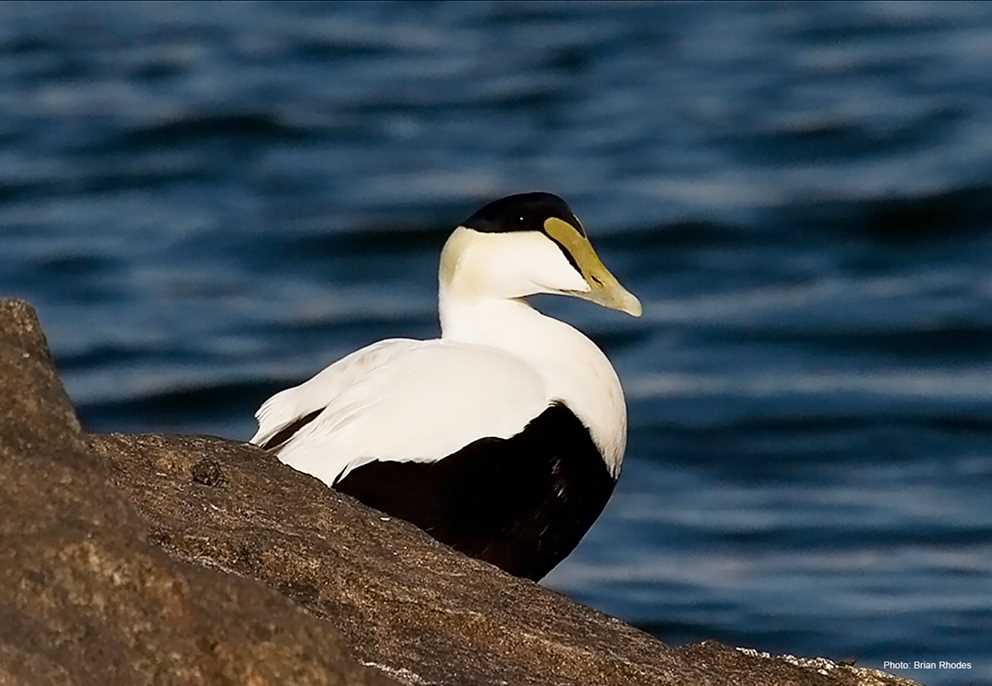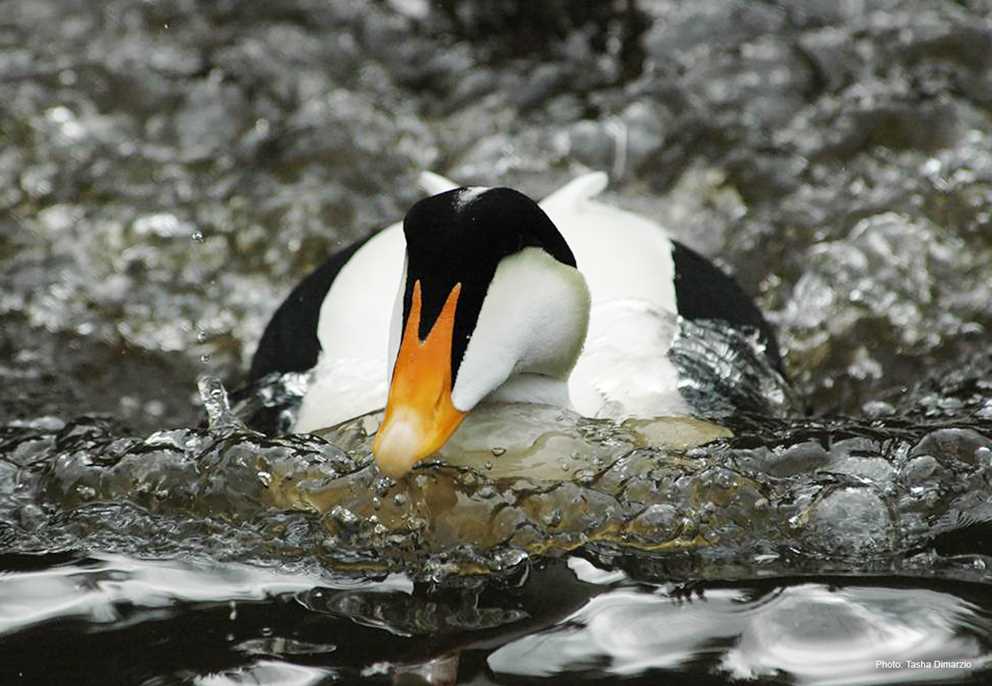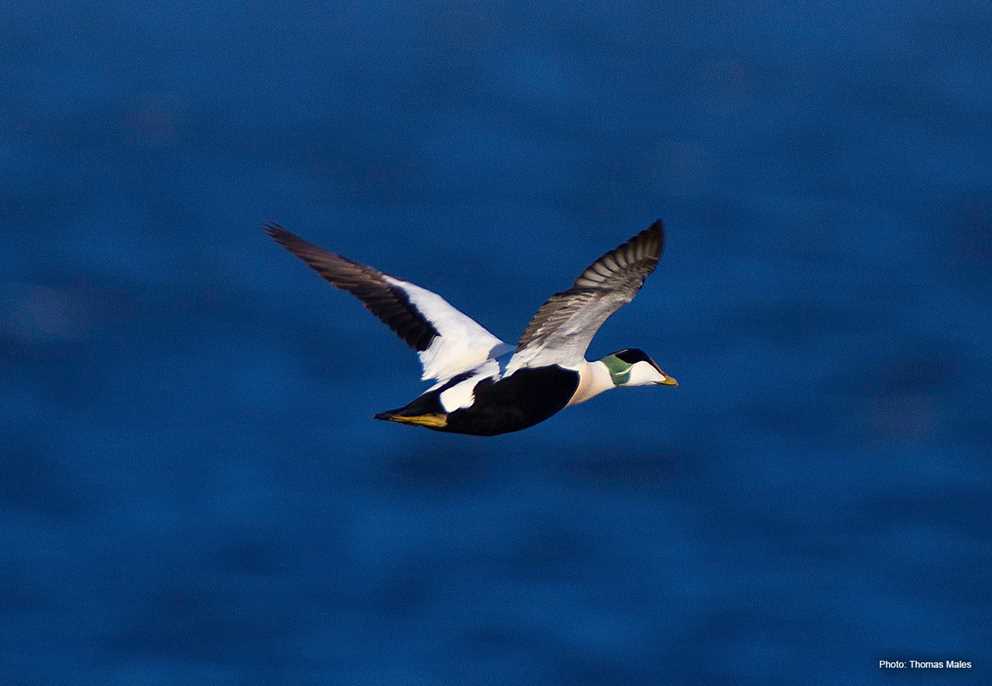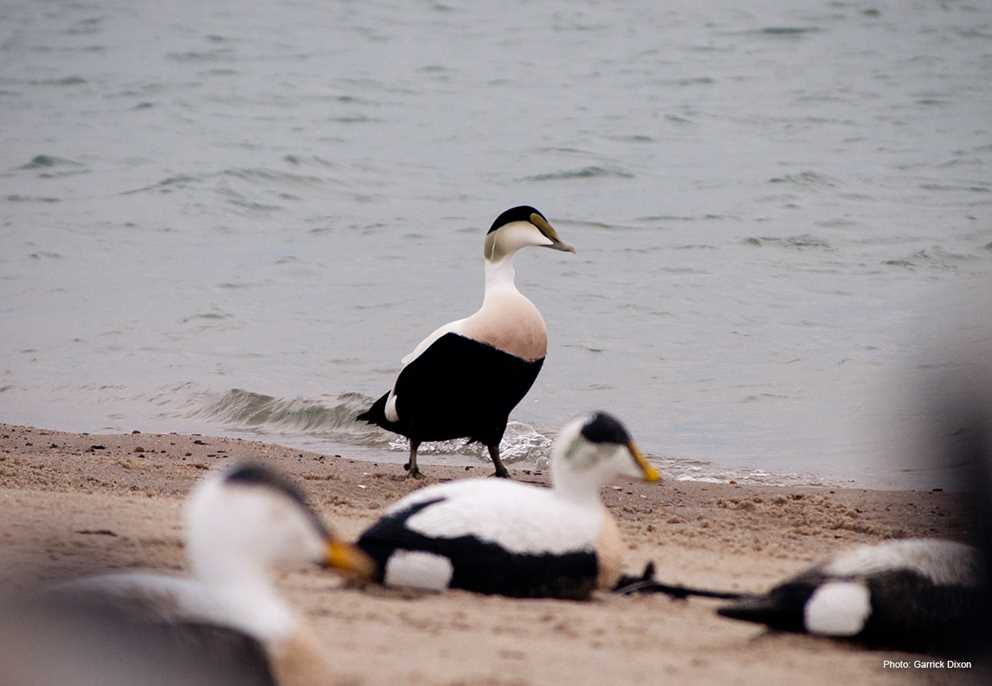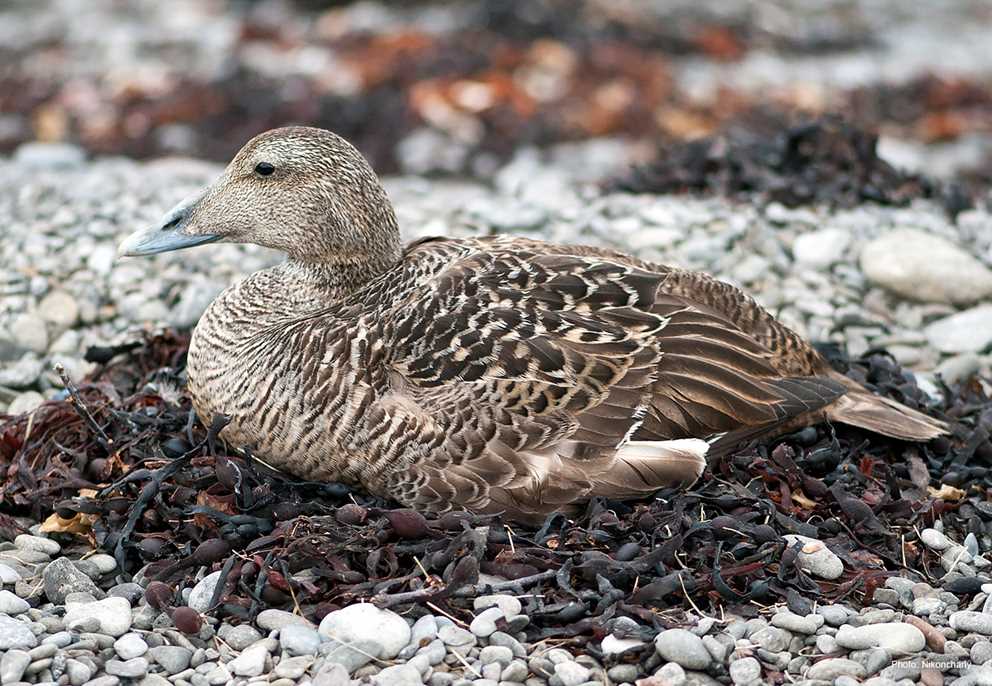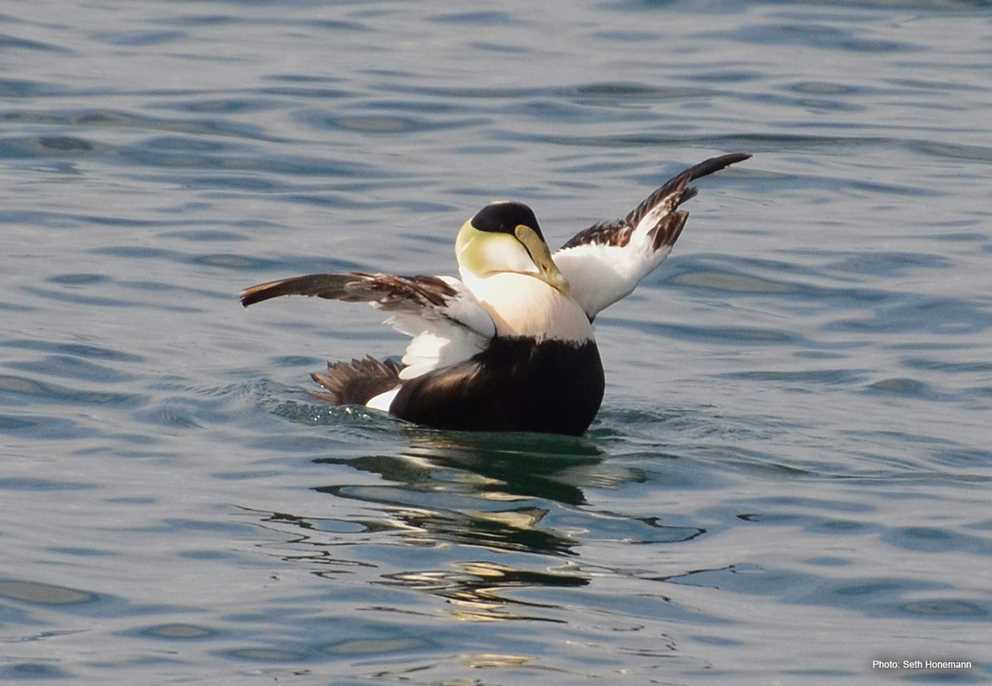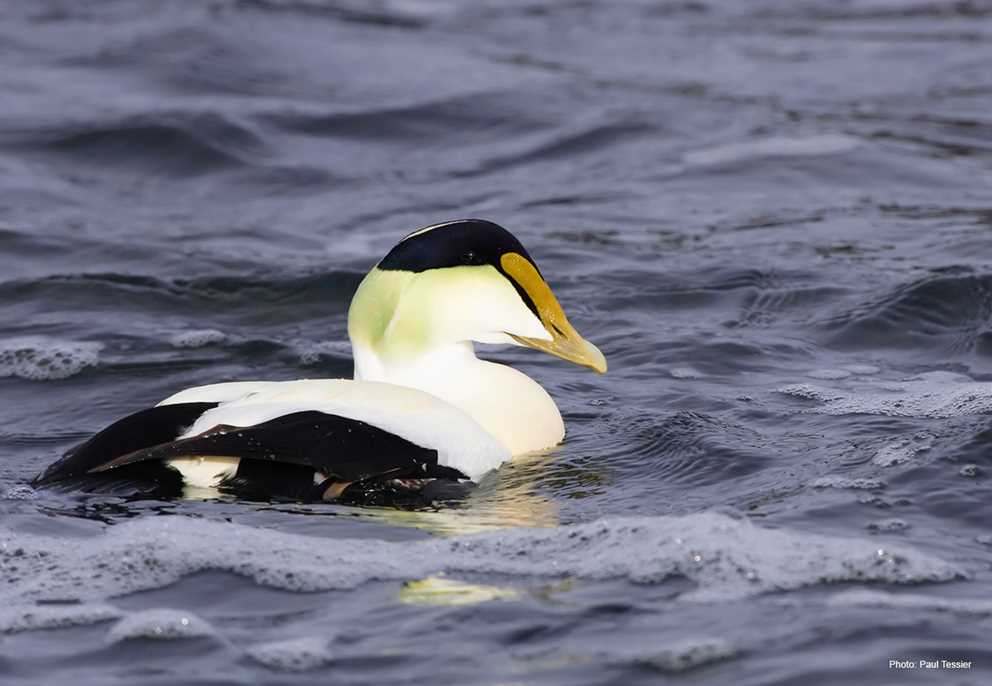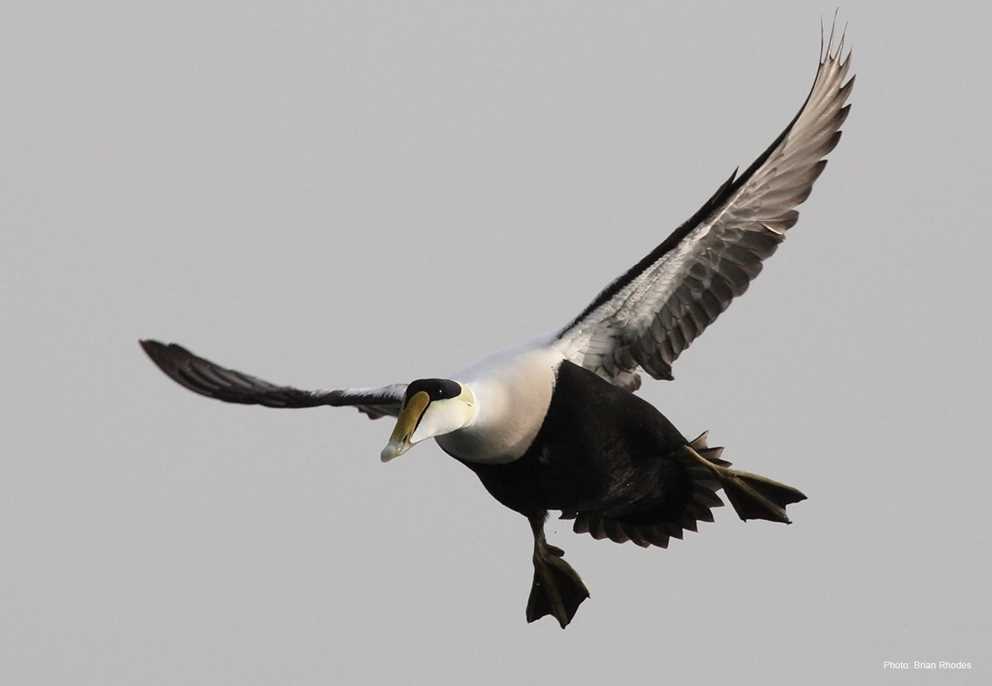Overview
The Common Eider is the largest sea duck (and the largest duck in North America) and has a circumpolar distribution. They are heavy-bodied with a long triangular, wedge-shaped bill. Males in alternate plumage are unmistakable with a black crown extending to below the eye, with a white streak on top of the head that extends down the nape, the remainder of the head is white with pale green patches below the eye and on the nape. The back is white, the belly, rump and vent are black. The bill is greenish gray with a pale tip. In flight the forewing shows a large white area contrasting with black secondary and primary feathers. Basic plumage of males is deep brown with some white feathers on the crown, and over the eye, and on the breast and wing coverts. Females are brown with black barring, a pale eye ring and faint eyestripe, and in flight may show two narrow white wing bars outlining a purplish-brown speculum. Definitive plumages occur at 3 to 4 years of age, with younger birds showing intermediate alternate/basic one and two plumages.
In North America, there are four subspecies:
- Pacific Common Eider (S. m. v-nigrum) which breeds from Nunavut west along the Beaufort and Bering Seas to the Aleutian Islands (also breeds in western Siberia), and winters in the Aleutian Islands;
- Dresser’s Common Eider (S. m. dresseri) which breeds from Labrador south to Massachusetts, winters from Cape Cod to Virginia;
- Northern Common Eider (S. m. borealis) breeds from Labrador and Newfoundland, north around the Ungava Peninsula west to Southampton Island and north to Ellesmere Island, also in Greenland, Iceland and Norway, winters southwest Greenland, southern Labrador, and the Gulf of St. Lawrence;
- Hudson Bay Common Eider (S. m. sedentaria) breeds and winters in confines of Hudson Bay.
Common Eiders are closely tied to marine habitats from which they rarely stray. They nest in large colonies on marine islands and form large wintering flocks in inshore coastal marine habitats. They overwinter as far north as open water persists, on the edge of pack ice, often associating with polynyas or in lee of islands devoid of pack ice. Common Eiders feed on mollusks and crustaceans. While Common Eiders are important in sea duck hunting, they are also particularly important to subsistence harvest in the north.
Description
Key Identification Features
- The adult male has a black crown extending below the eye, pale green below the eye and on the nape, with a white cheek, neck, breast and back, and a black belly, rump, and vent. The bill is grayish yellow with lobes extending to just forward of the eye with a pale-yellow tip.
- Females are brown overall with black barring and have a buffy eye ring and line through the eye, the bill is dark with lobes extending to just forward of the eye.
Male/Female Average Length and Weight
- Mass: Males 4.9–5.2 lbs.; Females 2.7–5.7 lbs.
- Wing Length: Males 8.2–12.1 in.; Females 10.6–11.9 in.; variation occurs among subspecies.
Male Identification
- Alternate (Breeding) Plumage: Males in alternate plumage are unmistakable with a black crown extending to below the eye, white streak on top of the head that extends down the nape, the remainder of the head is white with pale green patches below the eye and on the nape. The back is white while the belly, rump, and vent are black. The bill is greenish gray with a pale-yellow tip. In flight the forewing shows a large white area contrasting with black secondary and primary feathers.
- Basic Plumage: Basic plumage of males is deep brown with some white feathers on the crown, over the eye, and on the breast and wing coverts.
Female Identification
- Alternate and Basic Plumage: Similar to each other, females are brown with presence of black barring. Females show brown wings with narrow white margins above and below a purplish-brown speculum.
In-flight Identification
- Male: Males show a conspicuous white patch associated with the upper wing and middle coverts.
- Female: The female wing is brown with two narrow white margins outlining a purplish-brown speculum.
Vocalizations
- Male Calls: Males give a haunting, pigeon-like “cooo” sitting on water.
- Female Calls: Females may give a throaty “gog-gog-gog” during courtship or feeding, and croaks and groans during nest site searches.
Similar Species
- King Eiders: Adult male Common Eiders are distinctive in plumage and distinct from the other eiders and sea ducks. Females and immature males may be difficult to distinguish from King Eider females and immatures. Female King Eiders have a rounder head, are more reddish brown, and have more scalloped dark marking on the flanks, but separation is difficult.
Habitat Preferences
- Breeding: Common Eiders are colonial nesters, gathering in the thousands to tens of thousands on coastal islands, and narrow, low-lying points of land. Nests often in gravel, rocky, or mossy substrates in grasses, shrubs, or in some instances coniferous or mixed forest.
- Migration and Wintering: Migration and winter habitat is marine shoals and coastal areas up to about 65 feet in depth.
Foraging Habits and Diet
- Common Eiders primarily forage on invertebrates throughout the annual cycle. Echinoderms, mollusks, and crustaceans are frequently consumed.
Breeding Habits
- Monogamy: Common Eiders are considered seasonally monogamous, with pair bonds formed in winter and lasting until incubation.
- Nest Locations: Nesting begins in mid-June to early July. Females create a nest bowl lined with grasses, sedges and lichens, and deposit down as laying progresses. Nests are close to water on islands, peninsulas, or pond shorelines. Males depart nesting areas during incubation.
- Clutch Size: Averages of 3 to 5 eggs. The eggs are elliptical to sub-elliptical, variable color from olive-gray to tan or light brown, and size varies among subspecies, but ranges from 2.8–3.5 by 1.9–2.2 in. The incubation period averages 24 to 26 days.
Migration & Distribution
- Fall Migration: Common Eiders depart breeding areas in July or August prior to freezing. Initial movements are to molting areas and subsequently to migration and winter areas. Arrival on migration and winter areas variable, peaks in October and November.
- Spring Migration: Spring migration is from March to May, but peaks in April.

Conservation Status
- IUCN Status: Near Threatened
- Population Status: There is an estimated global population of 3.3–4 million birds, with the North American population being 1.5–2 million birds (winter estimate). Studies show some populations or subspecies of North America are declining though estimates are variable, monitoring data are insufficient, and access is difficult to achieve accurate census information.
- Conservation Concerns: The primary threats include habitat loss (including expansion of fisheries), oil spills, and climate change.
- Conservation Focus: Conservation efforts include monitoring Common Eiders to track dispersal and nesting habits, carefully managing hunter bag limits, and protecting their habitat.
Harvest Information
- Please note that this data is combined harvest data for Common and King Eiders.
- An average of 7,890 Common/King Eiders were harvested per season across the US during the 2019 through 2022 hunting seasons.
- Common/King Eider harvest is highest in the Atlantic Flyway, accounting for more than 90 percent of the total US harvest.
- The top three states for Common/King Eider harvest, based on annual averages across the 2019–2022 hunting seasons, were Massachusetts (4,194), Rhode Island (1,259), and Maine (1,078).
